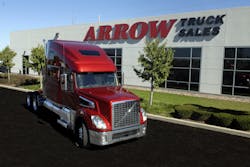Steve Clough, president of Arrow Truck Sales, projects that prices for used Class 8 tractors will continue weakening as the supply of such units continues to grow in the market; supply that is only poised only to increase down the road.
Speaking last week at the annual transportation conference hosted by research firm FTR, Clough noted that used truck prices are largely determined by prior-year new truck registrations and that those registrations started expanding significantly five years ago.
He pointed out that there had been no weakness in used Class 8 pricing until trucks sold new back in the 2011-2013 timeframe started coming into the market in recent months.
New U.S. Class 8 retail sales during that three-year time period topped 171,000, 195,000 and 185,000 units, respectively, according to FTR data, compared to 95,000 units in 2009 and 107,000 units in 2010.
As a result of that bump-up in supply, Class 8 wholesale and auction prices – particularly for used sleeper tractors – nosedived, according to Clough.
According to National Automobile Dealer Association (NADA) data posted this July, year-to-date used sleeper tractor prices dropped 15% for 2011 models, 16% for 2012 models, and 18% for 2013 models.
That’s only expected to worsen when the bumper crop of retail Class 8 trucks sold in the U.S. back in 2014 and 2015 of 220,000 units and 249,000 units, respectively, hit the market, Clough emphasized.
The sluggish freight environment of the past year is also depressing used Class 8 prices as well, he noted.
“Buyers of used trucks are not buying them because they love them; they are interested in how much cash they must invest in a vehicle,” Clough explained. “They must make a profit so at some point prices can’t go up in a market where making a profit is difficult. That’s why we began to see price resistance starting in 2015 when tonnage dropped and the spot rate softened.”
Another wrinkle in the used Class 8 market is that the cost to maintain them is rising significantly, he said, largely due to mandated exhaust emission control components, such as diesel particulate filters (DPFs) and selective catalytic reduction (SCR) systems.
“Used trucks today are very different mechanically than what buyers used to purchase; they really don’t want to hear about DPFs,” Clough pointed out. “Maintenance gets very expensive when things go wrong.”
About the Author
Sean Kilcarr
Editor in Chief
Sean Kilcarr is a former longtime FleetOwner senior editor who wrote for the publication from 2000 to 2018. He served as editor-in-chief from 2017 to 2018.

